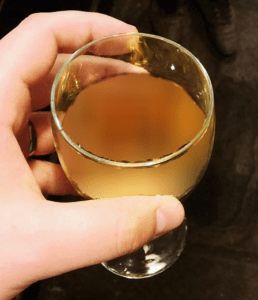 Three months ago I made my very first mead. I gathered some tips and advice before brewing, and was pleasantly surprised by how easy the process was.
Three months ago I made my very first mead. I gathered some tips and advice before brewing, and was pleasantly surprised by how easy the process was.
As recommended by Michael Fairbrother, I racked my mead to the secondary fermenter after three months in primary. Here it will sit for a while longer (if I can stand the wait), but how long should the mead stay in secondary? Let’s go ahead and transfer, take a gravity reading, and give the mead a taste.
Procedures for Racking to Secondary
- Clean and sanitize the new fermenter (for a one-gallon batch, I’m using a one-gallon glass jug), racking tube, auto-siphon, new bung and airlock
- Rack to fermenter – Take care not to aerate the mead. This can cause oxidation, which essentially makes the mead go stale.
- Withhold about 3/4 cup for testing (and tasting!)
- Take a hydrometer reading and do a taste test!
*If you are serious about making mead or small batch brewing, these tools can make sampling and testing so much easier: Wine thief, Refractometer.
Notes on the Mead
As you can imagine, after three months in the fermenter I was pretty excited to check out my mead. Here’s what I found:
- Appearance is pretty clear in the bucket. No floaters, very little yeast sediment, just a little yeast stuck around the sides of the bucket. Hydrometer sample has just a little haze, but not much.
- Upon opening the bucket, I got a waft of apple aroma – in beer this would be a no-no, but I suspect it’s normal in making mead. This didn’t really carry over to the taste.
- Taste – First I got the honey character, somewhat fruity but without the sweetness, followed by the gentle burn of alcohol, then graham cracker finish. Very nice!
- Gravity – Spot on the 1.000 mark – perhaps just a touch of residual sugar in there.
So, moving the mead to secondary…when will it be “ready”?
According to the AHA website: “It is up to the meadmaker how long they want to bulk-age before bottling. A few weeks to a few months is a good place to start.”
Another enthusiast site recommends the following: “The length of secondary fermentation varies, and it is okay to rack the must as many times as necessary to separate the mead from the lees. When you are satisfied with your mead, it is time to bottle.“ The site continues: “Store your mead in a cool dark place and let it age. It can be hard to judge when a mead will reach its peak so have fun sampling your wares from time to time. Congratulations on brewing your first batch of mead at home!”
recommends the following: “The length of secondary fermentation varies, and it is okay to rack the must as many times as necessary to separate the mead from the lees. When you are satisfied with your mead, it is time to bottle.“ The site continues: “Store your mead in a cool dark place and let it age. It can be hard to judge when a mead will reach its peak so have fun sampling your wares from time to time. Congratulations on brewing your first batch of mead at home!”
So it seems that aging mead is a pretty subjective process!
In my opinion, the mead already tastes great. I don’t think I will add any tannin, acid, or other flavorings. I’ll give it a few more weeks in secondary before I bottle, then note how the mead changes over time as I drink it!
I can’t get over how easy this mead was! I think it’s time to get another – larger – batch started!
Are you a mead maker? At what point do you find that your mead reaches peak flavor?
———————————————————————-
David Ackley is a beer writer, homebrewer, and self-described “craft beer crusader.” He holds a General Certificate in Brewing from the Institute of Brewing and Distilling and is founder of the Local Beer Blog.

I’m making my first batch of mead, seasoned with ginger, anise, and clove.
I’ve racked it off off the lees into secondary about a week ago. Now in it’s secondary, I’m finding a bit of sedement on the bottom of the vessel. Should I rack it again so soon?
Paul, the mead has only been in the secondary fermenter a week so at this time it is not necessary to rack the mead yet. If the secondary fermentation takes more that 2-3 weeks you might want to rack it again. Leaving it on the sediment for a short amount of time will not harm the mead or cause off flavors.